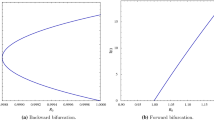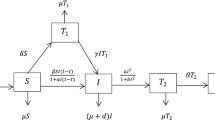Abstract
In this paper, a delay SIR model with a nonlinear incidence function and saturated treatment function is proposed and analyzed. The non-monotonous incidence function accounts for the behavior response of susceptible individuals towards the infective density in the population due to the impact of information about the disease. We obtain a threshold for disease persistence in the population. The system shows the possibility of multiple endemic equilibria. We analytically study the stability of endemic equilibrium, when it is unique. This stability of the unique endemic equilibrium depends on the delay parameter and is found to be locally asymptotically stable conditionally along with the existence of Hopf bifurcation. The direction and stability of Hopf-bifurcation are established analytically. Further, numerical results are provided in support of analytical findings. Numerically, we observe stability switch of unique endemic equilibrium and existence of endemic bubble due to change in delay parameter. We further exhibited the impact of delay when multiple equilibria are present in the system. In this case, we observe that bi-stable endemic equilibria in absence of delay can be transformed to oscillatory bi-stable limit cycles in presence of delay (when the delay is sufficiently large). Here the delay causes the change in stability of both the equilibria by generating two local Hopf bifurcations around both the equilibria which were stable in absence of delay. We also investigated the effect of information and disease transmission rate on disease persistence along with the incubation delay length. Thus, we conclude that the nonlinearity and delays in the model system account for rich and complex dynamics.








Similar content being viewed by others
References
Das, T., Srivastava, P.K., Kumar, A.: Nonlinear dynamical behavior of an SEIR mathematical model: effect of information and saturated treatment. Chaos Interdiscip. J. Nonlinear Sci. 31(4), 043104 (2021)
Li, G.H., Zhang, Y.X.: Dynamic behaviors of a modified SIR model in epidemic diseases using nonlinear incidence and recovery rates. PloS One 12(4), 0175789 (2017)
Shan, C., Zhu, H.: Bifurcations and complex dynamics of an SIR model with the impact of the number of hospital beds. J. Differ. Equ. 257(5), 1662–1688 (2014)
Yadav, A., Srivastava, P.K.: The impact of information and saturated treatment with time delay in an infectious disease model. J. Appl. Math. Comput. 66(1), 277–305 (2021)
Zhang, X., Liu, X.: Backward bifurcation of an epidemic model with saturated treatment function. J. Math. Anal. Appl. 348(1), 433–443 (2008)
Capasso, V., Serio, G.: A generalization of the kermack-mckendrick deterministic epidemic model. Math. Biosci. 42(1–2), 43–61 (1978)
Cui, J., Sun, Y., Zhu, H.: The impact of media on the control of infectious diseases. J. Dyn. Differ. Eq. 20(1), 31–53 (2008)
Liu, R., Jianhong, Wu., Zhu, H.: Media/psychological impact on multiple outbreaks of emerging infectious diseases. Comput. Math. Methods Med. 8(3), 153–164 (2007)
Liu, Y., Cui, J.: The impact of media coverage on the dynamics of infectious disease. Int. J. Biomath. 1(01), 65–74 (2008)
Min, L., Huang, J., Ruan, S., Pei, Y.: Bifurcation analysis of an SIRS epidemic model with a generalized nonmonotone and saturated incidence rate. J. Differ. Equ. 267(3), 1859–1898 (2019)
Xuejuan, L., Wang, S., Liu, S., Li, J.: An SEI infection model incorporating media impact. Math. Biosci. Eng. 14(5&6), 1317 (2017)
Pan Q, Huang J, Huang Q: Global dynamics and bifurcations in a SIRS epidemic model with a nonmonotone incidence rate and a piecewise-smooth treatment rate. Discrete and Continuous Dynamical Systems-B, (2021)
Rohith, G., Devika, K.B.: Dynamics and control of covid-19 pandemic with nonlinear incidence rates. Nonlinear Dyn. 101(3), 2013–2026 (2020)
Song, P., Xiao, Y.: Analysis of an epidemic system with two response delays in media impact function. Bull. Math. Biol. 81(5), 1582–1612 (2019)
Gao, J., Zhao, M.: Stability and bifurcation of an epidemic model with saturated treatment function. In: International Conference on Information and Management Engineering, pp 306–315. Springer, (2011)
Ghosh, J.K., Majumdar, P., Ghosh, U.: Qualitative analysis and optimal control of an SIR model with logistic growth, non-monotonic incidence and saturated treatment. Math. Model. Natl. Phenom. 16, 13 (2021)
Dubey, P., Dubey, B., Dubey, U.S.: An SIR model with nonlinear incidence rate and Holling type III treatment rate. In: Applied Analysis in Biological and Physical Sciences, pp 63–81. Springer, (2016)
Kumar, A. and Nilam: Dynamical model of epidemic along with time delay; holling type II incidence rate and monod-haldane type treatment rate. Differ. Eq. Dyn. Syst. 27(1–3), 299–312 (2019)
Kaddar, A., Abta, A., Alaoui, H.T.: A comparison of delayed SIR and SEIR epidemic models. Nonlinear Anal Model. Control 16(2), 181–190 (2011)
Abta, A., Kaddar, A., Alaoui, H.T.: Global stability for delay SIR and SEIR epidemic models with saturated incidence rates. Electron. J. Differ. Eq. 2012(23), 1–13 (2012)
Liu, Z.: Dynamics of positive solutions to SIR and SEIR epidemic models with saturated incidence rates. Nonlinear Anal. Real World Appl. 14(3), 1286–1299 (2013)
Avila-Vales, E., Pérez, Á.G.C.: Dynamics of a time-delayed SIR epidemic model with logistic growth and saturated treatment. Chaos Solitons Fractals 127, 55–69 (2019)
Kumar, A., Goel, K., Nilam.: A deterministic time-delayed SIR epidemic model: mathematical modeling and analysis. Theory Biosci. 139(1), 67–76 (2020)
Kumar, A. and Nilam: Mathematical analysis of a delayed epidemic model with nonlinear incidence and treatment rates. J. Eng. Math. 115(1), 1–20 (2019)
Naresh, R., Tripathi, A., Tchuenche, J.M., Sharma, D.: Stability analysis of a time delayed SIR epidemic model with nonlinear incidence rate. Comput. Math. Appl. 58(2), 348–359 (2009)
Enatsu, Y., Messina, E., Muroya, Y., Nakata, Y., Russo, E., Vecchio, A.: Stability analysis of delayed SIR epidemic models with a class of nonlinear incidence rates. Appl. Math. Comput. 218(9), 5327–5336 (2012)
Liu, L.: A delayed SIR model with general nonlinear incidence rate. Adv. Differ. Equ. 2015(1), 1–11 (2015)
Yan, C., Jia, J.: Hopf bifurcation of a delayed epidemic model with information variable and limited medical resources. In: Abstract and Applied Analysis, vol 2014. Hindawi, (2014)
Liu, M., Liz, E., Rost, G.: Endemic bubbles generated by delayed behavioral response: global stability and bifurcation switches in an SIS model. SIAM J. Appl. Math. 75(1), 75–91 (2015)
Rai, R.K., Misra, A.K., Takeuchi, Y.: Modeling the impact of sanitation and awareness on the spread of infectious diseases. Math. Biosci. Eng. 16(2), 667–700 (2019)
Kumar, A., Srivastava, P.K., Yadav, A.: Delayed information induces oscillations in a dynamical model for infectious disease. Int. J. Biomath. 12(02), 1950020 (2019)
El-Morshedy, H.A., Ruiz-Herrera, A.: Asymptotic convergence in delay differential equations arising in epidemiology and physiology. SIAM J. Appl. Math. 81(4), 1781–1798 (2021)
Abta, A., Boutayeb, S., Laarabi, H., Rachik, M., Alaoui, H.T.: Stability analysis of a delayed SIR epidemic model with diffusion and saturated incidence rate. SN Partial Differ. Eq. Appl. 1(4), 1–25 (2020)
Laarabi, H., Abta, A., Hattaf, K.: Optimal control of a delayed SIRS epidemic model with vaccination and treatment. Acta Biotheoretica 63(2), 87–97 (2015)
Li, M., Liu, X.: An SIR epidemic model with time delay and general nonlinear incidence rate. In: Abstract and Applied Analysis, vol 2014. Hindawi, (2014)
Liu, J.: Hopf bifurcation analysis for an SIRS epidemic model with logistic growth and delays. J. Appl. Math. Comput. 50(1–2), 557–576 (2016)
Hale, J.K.: Functional differential equations. In: Analytic theory of differential equations, pp 9–22. Springer, (1971)
Van den Driessche, P., Watmough, J.: Reproduction numbers and sub-threshold endemic equilibria for compartmental models of disease transmission. Math. Biosci. 180(1–2), 29–48 (2002)
Hassard, B.D., Hassard, B.D., Kazarinoff, N.D., Wan Y.-H, and Wan, Y.W.: Theory and applications of Hopf bifurcation, volume 41. CUP Archive, (1981)
Cooke, K.L., Grossman, Z.: Discrete delay, distributed delay and stability switches. J. Math. Anal. Appl. 86(2), 592–627 (1982)
Acknowledgements
T Das is thankful to Indian Institute of Technology Patna for financial support. P.K.S. acknowledges financial support from SERB (DST) (Project No. MTR/2017/000803). The authors thank the anonymous referees and handling editor for their valuable input that has improved manuscript significantly.
Author information
Authors and Affiliations
Corresponding author
Additional information
Publisher's Note
Springer Nature remains neutral with regard to jurisdictional claims in published maps and institutional affiliations.
Appendix
Appendix
1.1 Basic reproduction number
Following [38], we obtain the next generation matrix at the disease free equilibrium point \(E_1=(K,0,0)\) for the model system (1) which is given by,
Here note that I(t) is the single infective compartment. Now, the basic reproduction number is given by spectral radius of \(FV^{-1}\) which is \(\frac{\beta K}{d+\delta +\alpha }\). Therefore,
Rights and permissions
About this article
Cite this article
Das, T., Srivastava, P.K. Hopf bifurcation and stability switches in an infectious disease model with incubation delay, information, and saturated treatment. J. Appl. Math. Comput. 68, 4135–4159 (2022). https://doi.org/10.1007/s12190-022-01702-5
Received:
Revised:
Accepted:
Published:
Issue Date:
DOI: https://doi.org/10.1007/s12190-022-01702-5




